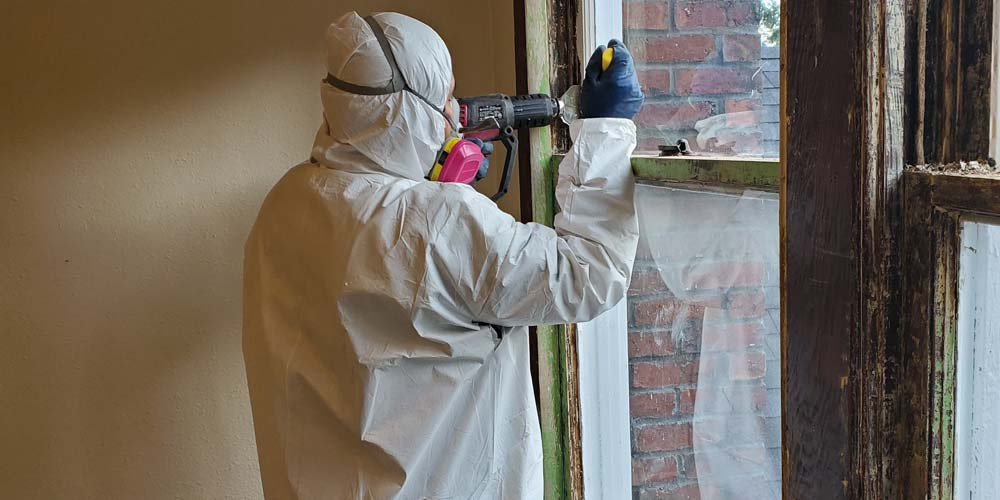Finest Practices for Ensuring Safe and Thorough Lead Infraction Reduction
Resolving lead violation abatement needs a multi-faceted strategy to guarantee both safety and security and compliance. First assessments utilizing innovative discovery approaches such as XRF analyzers set the stage for an exact understanding of contamination degrees. Incorporating appropriate control techniques, including airtight obstacles and HEPA filtration, paired with using personal protective devices (PPE) for workers, forms the foundation of a safe and secure operation. Precise clean-up methods, featuring HEPA vacuuming and wet-wiping, are important. Yet, it's the final clearance process, involving detailed evaluations and research laboratory testing, that genuinely verifies a lead-free atmosphere, making sure lasting safety and security. Exactly how do these practices interconnect to ensure extensive lead abatement?

Preliminary Analysis
Carrying out a first assessment is a vital primary step in lead infraction reduction. This stage includes a comprehensive assessment of the home to recognize the presence, degree, and details locations of lead-based threats. Certified experts, such as licensed lead inspectors or risk assessors, should do an extensive website inspection, utilizing devices like X-ray fluorescence (XRF) analyzers to accurately discover and measure lead concentrations in paint, dust, soil, and water.
The analysis should additionally include an evaluation of the structure's background, previous reports, and any type of complaints or wellness issues reported by passengers - Lead Removal Contractors. Recording the findings meticulously is essential, as these documents form the basis for establishing an efficient abatement approach. An extensive assessment likewise includes sampling and laboratory analysis, which are vital to confirm the existence of lead and overview succeeding actions
In addition, it is necessary to interact the results transparently to all stakeholders, including residential or commercial property owners, occupants, and governing authorities. By ensuring that the initial assessment is conducted with accuracy and roughness, specialists can lay a strong structure for a targeted and reliable lead reduction process, eventually safeguarding public wellness and making certain conformity with governing requirements.
Appropriate Control
Correct control is critical to avoid the spread of lead contaminants throughout abatement tasks. Efficiently managing control reduces the risk of lead dust and debris moving to non-work areas, thus guarding both the setting and individuals outside the prompt work zone.

Regular evaluations of the control area are necessary to look for breaches or weak points in the obstacle. Any kind of determined problems must be immediately addressed to keep the honesty of the containment. By sticking to these practices, abatement tasks can properly control lead contamination and mitigate affiliated wellness risks.
Worker Protection
Guaranteeing worker security is paramount during lead reduction jobs to avoid work exposure to hazardous lead fragments. Important steps consist of making use of personal safety equipment (PPE) such as respirators, gloves, and full-body matches especially designed to obstruct lead dust and fumes. Workers should undertake thorough training on the right use and upkeep of PPE, consisting of fit testing for respirators to ensure optimum efficacy.
Engineering controls, such as regional exhaust air flow systems, are crucial in reducing air-borne lead focus in the job setting. Management controls ought to likewise be executed, consisting of restricting the duration of direct exposure and turning employees to reduce individual exposure times. Routine clinical monitoring and organic monitoring are essential for very early discovery of lead absorption, making it possible for timely intervention and therapy.
Furthermore, developing a purification protocol is crucial. Employees must comply with rigid purification treatments before breaks and at the end of their shift to stop lead dirt from being lugged outside the workspace. This includes detailed hand and face washing with lead-specific cleaner and altering out of polluted clothes.
Meticulous Cleaning
Maintaining a risk-free workplace extends beyond employee protection and includes careful cleaning to make certain lead particles are extensively removed from the website. The process of precise clean-up is crucial in preventing the recontamination of the mellowed out area and protecting both existing and future owners.
To achieve a detailed cleanup, all workplace need to be systematically decontaminated. This entails using specialized HEPA (High-Efficiency Particulate Air) vacuum cleansers and wet-wiping methods to capture and eliminate great lead dirt that may have worked out on surface areas. It is necessary to clean all horizontal surfaces, including floors, home window sills, and counter tops, as well as upright surface areas that may have trapped lead fragments.
Workers should use ideal personal protective tools (PPE) during cleaning to stay clear of direct exposure to residual lead dirt. Utilized cleaning products such as wipes, sponges, and wipe heads must be taken care of based on unsafe waste disposal policies.

Final Clearance
Last clearance is the essential concluding stage of lead abatement that figures out whether the website is risk-free for reoccupation. This essential action involves detailed assessment and testing to verify that all lead risks have Lead Violation Removal in NYC been properly gotten rid of. The procedure begins with a visual inspection by a certified lead-based paint examiner or risk assessor to guarantee no visible dust or debris continues to be. This is adhered to by collecting dust wipe examples from various surface areas, including floorings, windowsills, and other straight surface areas. Lead Removal Contractors.

Final clearance screening not only shields future occupants however additionally makes certain compliance with neighborhood, state, and government guidelines. Moreover, it functions as a documented recognition of the abatement contractor's adherence to sector ideal techniques. Ensuring a comprehensive and effective last clearance is necessary in safeguarding public health and cultivating rely on the abatement process.
Verdict
Making certain secure and complete lead infraction abatement demands a multifaceted approach encompassing initial assessments with advanced detection techniques, reliable control techniques, strict worker security protocols, and meticulous cleanup procedures. The final clearance phase, including comprehensive examinations and lab screening, is critical to validate compliance with EPA criteria. Adherence to these best practices assures a secure environment for residents, mitigates health and wellness dangers, and maintains regulatory needs, therefore advertising public health and wellness and safety in lead-affected locations.